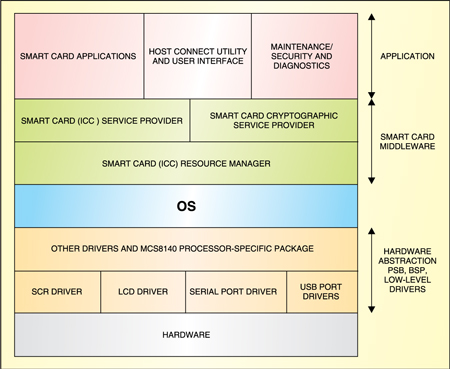Power. The functioning of a smart card, especially the communication task, requires power. While some cards require contact to source power, some contactless ones (certain models of near-field communication (NFC) smart cards and radio frequency identification (RFID) smart cards) are capable of drawing power from the terminal itself during the read operation. The mode of powering a smart card, however, depends largely on the functions performed and the power required for these. There is pressure on the industry to reduce the size of the power unit and increase its efficiency. Here and there, we even see examples of alternate power sources such as solar energy being used to power smart cards.
Performance. Manufacturers are rapidly increasing the performance of smart cards, in order to fulfil the needs of advanced applications ranging from multi-application subscriber identity modules (SIMs) and e-payments to ticketing. Apart from processor performance, high code density and task isolation also support the rapidly evolving smart card applications.
Price factor. Reduction in price is a very important precondition for extensive adoption of smart cards. The smart card processor industry is trying to meet this need for lowering cost by minimising the gate count, increasing the code density and making the card features (including security) more configurable. “With these, the industry would be able to serve slowing markets, spread software investment across the product portfolio, and deliver multiple devices with the same core,” explains Sahai.
Smart card terminals to catch the data
Depending on the application that the smart cards are being put to, the terminals will differ in functionality as well as form factor.
“Due to the wide range of smart card applications, the smart card terminal requirements may vary from application to application. Typically, a smart card terminal system can be broadly classified into two types: PC/workstation with a USB or other port based smart card read/write peripheral device; or self-contained wired or wireless embedded system which may integrate the smart card reader/writer or be used as a peripheral (point-of-sale applications),” explains Reddy.
The functionality of a smart card would also vary depending on the requirements. It might be a terminal with read-only access—one with card-read and application-specific restricted data-write access—or a terminal or development system capable of loading applications as well as reading and writing smart card information (keys and data). The various functions can be easily controlled through different software builds. In addition, firewalls can restrict access permissions based on the security key.
Speaking to each other
Additionally, the smart card and terminal might require contact or be contactless. Contactless setups use various communication technologies such as radio frequency (RF) induction. RF communication does not require line-of-sight and hence these smart cards can be used for such applications as transportation or automatic billing. A travel card, for example, can be automatically read and updated when a person boards or gets off a bus or train.

Various communication protocols have been defined by the International Organisation for Standardisation (ISO) for smart card communications. T=0 is a character-level transmission protocol defined in ISO/IEC 7816-3 and T=1 is a block-level transmission protocol defined in ISO/IEC 7816-3, while ISO/IEC 14443 governs application protocol data unit transmission via a contactless interface.
Near-field communications (NFC), a short-range high frequency wireless communication technology, is also emerging as a complementary technology for smart cards. It enables the exchange of data between devices placed within 10 cm (four inches) from each other. Wikipedia states that the technology is a simple extension of the ISO/IEC 14443 proximity-card standard that combines the interface of a smart card and a reader into a single device. An NFC device can communicate with both existing ISO/IEC 14443 smart cards and readers, as well as with other NFC devices, and is thereby compatible with existing contactless infrastructure that might have already been deployed.
Getting on the information highway
A smart card holds information, which is read or written using terminals of various kinds. However, all this would be of no use unless the terminal is connected to the ‘information highway’. “Smart ID cards can be deployed by building an information highway and facilitating information sharing between different agencies and departments,” comments Lugani of Wipro.
Essentially, every reader would send the information it captures over a network, authenticate the ID details by comparing it with a central database, process and update the information on the smart card if needed and also reflect any status updates to the central repository as well. This information can then be used by various agencies, making sure that all concerned parties access one, up-to-date version of the information. You would no longer have to contend with having one address on your ration card and another on your voter’s ID!






